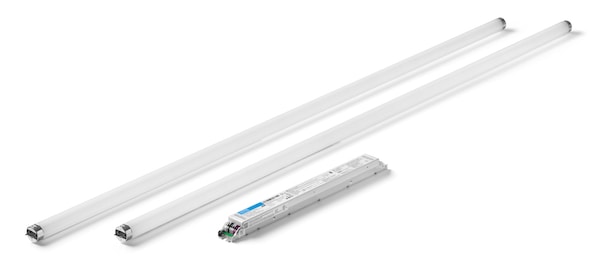By Tom Shearer
The fluorescent lighting era is coming to an end. Half a dozen U.S. states, and Canada have introduced legislation banning or restricting the sale of fluorescent lamps. Additional states are considering similar measures. Many of these state restrictions stem from state mandates enacted to protect residents from exposure to the mercury that can leach out of the estimated 75% of improperly disposed fluorescent bulbs.
Even if your state is not currently considering a fluorescent ban, you will ultimately feel the legislation’s impact. As restrictions on fluorescent lighting continue to reduce overall market demand, more manufacturers will stop producing fluorescent lamps and ballasts, and it will get increasingly difficult to maintain fluorescent lighting in the event of lamp or ballast failure.

The good news is that LED upgrades are fast, straightforward and offer significant sustainability and operational benefits. LEDs are mercury-free and energy-efficient. They feature long lamp life—resulting in fewer lamps being purchased, less packaging, and less raw material used over time—all while delivering higher performance and greater control flexibility than fluorescents.
LED solutions also provide tremendous design flexibility. Today, there are many options for upgrading to LED lighting (including wireless lighting controls) that can improve light quality and simplify maintenance, helping to transform lighting from an operational necessity to a building asset that drives property value and enhances sustainability.
To reliably keep the lights on and provide a more efficient space, now is the time to plan your LED retrofit. We’ll highlight four factors to consider when replacing outdated fluorescent lighting with an LED solution optimized to support your building requirements.
1. Assess Your Current Lighting Situation
While LEDs are the clear path forward, much of the commercial lighting in North America is still switched fluorescent. The first step is to understand where you are using fluorescent lighting that needs to be updated, and whether you have an installed lighting control system you’d like to maintain.
In many cases, you can easily replace fluorescent lamps and ballasts with LED lamps and drivers using your existing controls. Most digital control systems will work seamlessly with LED upgrade kits and do not require extensive rewiring or opening of walls or ceilings. If you want to add or enhance control capabilities, an LED upgrade presents the perfect opportunity to do so with minimal impact on the people in the space.
2. Consider Your Short- And Long-Term Goals
Are you planning to institute a lighting upgrade as a major renovation project, or do you want to start small and complete an upgrade over time? With LED retrofit kits, you have various options that work well with both your schedule and budget. If you plan to upgrade over time, retrofit kits let you start with a single fixture or all the fixtures in a given area, methodically working through the property in the way that makes the most sense for your facilities team. By phasing retrofit projects in manageable chunks, you can minimize disruptions and easily stay within your operating budget.
Look for retrofit kits that bundle the LED lamp with the appropriate driver to ensure compatibility and simplify installation. Many kitted options improve light quality and ensure uninterrupted lighting performance in a straightforward process that can often be completed without replacing existing fixtures. Kits provide a simple, one-to-one replacement. Swap out fluorescent tubes and ballasts with the LED lamps and drivers and keep your existing fixtures and controls.

LED lamps, compatible drivers, instructions, and connectors (Pictured: Lutron ballast retrofit kit by C-Flex).
3. Evaluate The Benefits Of A Comprehensive System Upgrade
A large-scale lighting retrofit is the perfect opportunity for many properties to install a digital lighting control solution, maximizing the LED upgrade’s performance, operation, and energy-saving advantages.
For buildings with basic, switched fluorescent lighting, LED upgrades present the perfect opportunity to consider how smart lighting control systems facilitate collection and analysis of energy and space-use data to magnify the efficiencies of your upgrade lighting.
Many upgrades can use existing lighting control infrastructure—no opening walls or running new wiring necessary. Because LED drivers are digital, they can easily integrate with a smart lighting control system to facilitate superior dimming and color-temperature adjustments, making the space more comfortable and versatile while enhancing value. As part of a comprehensive lighting retrofit, you can install a wireless, energy-code-compliant control system quickly and with relatively low labor costs.
4. Communicate With Your Stakeholders
Decision makers are focused on upgrades that reduce cost and enhance property value. Talk with them about how an LED retrofit can help improve energy savings, simplify maintenance, and meet performance goals.
Where cost is a sticking point, emphasize the simplicity of LED retrofit kits. Reinforce the ability to replace fluorescent lamps and ballasts without impacting existing controls. And take advantage of the opportunity to support other corporate initiatives. For example, are they just looking to mitigate problems with obsolete fluorescent lighting, or do they want to enhance building value with improved dimming performance and analytics that help streamline operations? An updated LED lighting and control system offers tools to help meet a wide variety of goals.
Integrating Lighting Controls
Many of today’s digital lighting control systems are cloud-connected, ensuring system updates are delivered automatically and seamlessly. It’s easier than ever to add features and capabilities via software rather than hardware, so your lighting system keeps getting smarter over time.
You don’t have to do it alone—count on your controls manufacturer to offer valuable support and in-depth information about driver compatibility and performance. LED retrofits create opportunities to add value to the property and build ongoing relationships with your clients.
Embrace the energy-saving power of LEDs to enhance light quality in all your projects, creating a more occupant-friendly and future-proof environment.
 Shearer is the Sales Engineering Leader for Lutron Electronics, and he led the development of Lutron LED driver products. He holds patents in the areas of LED driver technology, and control of tunable white lighting. Shearer is a member of the Illuminating Engineering Society (IES), and the Institute of Electrical and Electronics Engineers (IEEE) and has presented at technical seminars and conferences on the topic of LEDs, LED drivers, and lighting control in general.
Shearer is the Sales Engineering Leader for Lutron Electronics, and he led the development of Lutron LED driver products. He holds patents in the areas of LED driver technology, and control of tunable white lighting. Shearer is a member of the Illuminating Engineering Society (IES), and the Institute of Electrical and Electronics Engineers (IEEE) and has presented at technical seminars and conferences on the topic of LEDs, LED drivers, and lighting control in general.





















![[VIDEO] Collect Asset Data at the Speed of Walking a Building](https://facilityexecutive.com/wp-content/uploads/2024/02/maxresdefault-324x160.jpg)